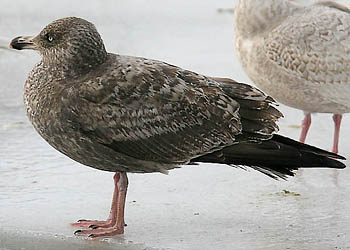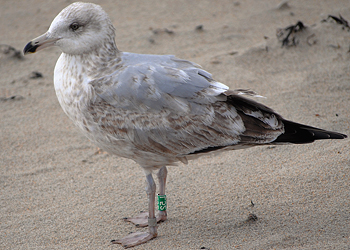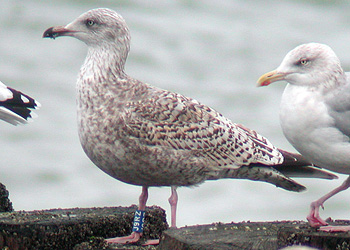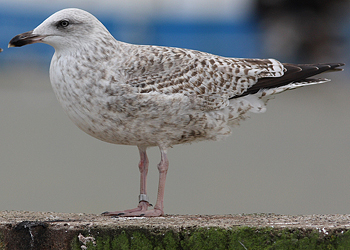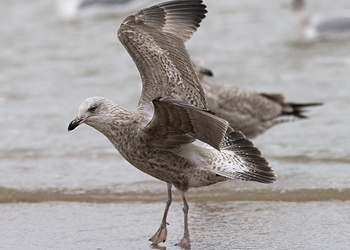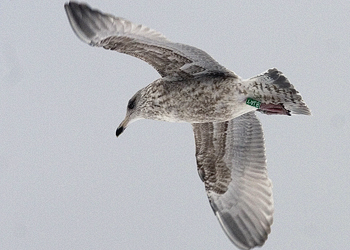 Vega Gull (vegae) / セグロカモメ / 재갈매기
Vega Gull (vegae) / セグロカモメ / 재갈매기
(last update: December 2015)
Vega Gull (vegae) 2nd cycle / 3CY January
The thumbnails show some Vega Gulls (vegae) in 2nd cycle, several photographed between December 27 2009 - January 04 2010, Choshi, Japan, by Chris Gibbins.
They have 2nd gen flight feathers, sometimes with faint mirror on P10. There is often thin vermiculation at the tops of innerwebs of P2-P4, similar to European Herring Gull. They are very pale on rump and proximal half of rectrices, unlike American Herring Gull. Markings on undertail coverts are widely spaced, like in European brds, unlike American Herrings. If any grey tone is present on the fresh feathers, this is a shade darker than on argenteus and on smithsonianus.
2nd generation flight feathers. In some birds, the new scapulars reflect the grey tone of adult plumage.
After the complete moult in the summer months, some 2CY birds may start a subsequent limited moult in upper tertials and/or inner wing-coverts. In these birds, the new coverts (and new scapulars) often reflect the grey tone of adult plumage. The partial autumn moult took place in September-October, but the generation division is still obvious by January.
Second cycle (2nd winter) American Herring Gull smithsonianus
In Dutch Birding Vol 26-01 2004 Lonergan & Mullarney address 9 criteria for identification of 2nd cycle (2nd winter) smithsonianus in a flock of European Herring Gull argentatus and argenteus. With growing age, a smaller proportion of smithsonianus remains "acceptable" in a European context (maybe a minority, but not quantified?) The differences between American smithsonianus and European argentatus/argenteus may aslo hold for Vega Gull vegae.
- solid brown feathers in neck (brown boa) without any lining, form a sharp division to mantle. From the neck the solid texture continues to side of breast and flank.
- tertials with extensive very dark centres, hardly a pale tip. No transversal lines and hardly any notching.
- undertail coverts and vent with dense barring, ideally reducing the pale parts into pairs of spots, and the longest undertail coverts completely dark on the centres.
- uppertail coverts and rump densely barred in fall. Late winter feathers of rump will be replaced for white feathers.
- tail feathers ideally completely blackish, including most of the outerweb of R6.
- bi-coloured bill like in Glaucous Gull hyperboreus.
- primaries in smithsonianus similar to argentatus, but only seldom with mirror on P10.
- underwing coverts solid brown, lacking any barring.
- uniform greater coverts, limited lining or barring.
- upperparts, A: if brown, then hardly any barring but uniform back, scapulars with dark triangular centre and pale fringe; B: if back is grey, then often contrast between grey back and brown shawl in neck, brown coverts and brown underparts.
And below are a few example birds from Europe: Herring Gull argentatus.
 Vega Gull (vegae), 2nd cycle (3CY), January 31 2004, Hasaki Xingang, Japan. Picture: Akimichi Ariga.
Vega Gull (vegae), 2nd cycle (3CY), January 31 2004, Hasaki Xingang, Japan. Picture: Akimichi Ariga. Vega Gull (vegae), 2nd cycle (3CY), January 29 2005, Hasaki Xingang, Japan. Picture: Akimichi Ariga.
Vega Gull (vegae), 2nd cycle (3CY), January 29 2005, Hasaki Xingang, Japan. Picture: Akimichi Ariga. Vega Gull (vegae), 2nd cycle (3CY), January 29 2005, Hasaki Xingang, Japan. Picture: Akimichi Ariga.
Vega Gull (vegae), 2nd cycle (3CY), January 29 2005, Hasaki Xingang, Japan. Picture: Akimichi Ariga. Vega Gull (vegae), 2nd cycle (3CY), January 29 2005, Hasaki Xingang, Japan. Picture: Akimichi Ariga.
Vega Gull (vegae), 2nd cycle (3CY), January 29 2005, Hasaki Xingang, Japan. Picture: Akimichi Ariga. Vega Gull (vegae), 2nd cycle (3CY), January 29 2005, Hasaki Xingang, Japan. Picture: Akimichi Ariga.
Vega Gull (vegae), 2nd cycle (3CY), January 29 2005, Hasaki Xingang, Japan. Picture: Akimichi Ariga. Vega Gull (vegae), 2nd cycle (3CY), January 29 2005, Hasaki Xingang, Japan. Picture: Akimichi Ariga.
Vega Gull (vegae), 2nd cycle (3CY), January 29 2005, Hasaki Xingang, Japan. Picture: Akimichi Ariga.
